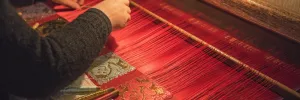Industry news

6 min

The traditional handlooms and crafts, once the pride of Indian heritage, are now on the brink of extinction due to the decline of regular buyers, scarcity of raw material and the subsequent and increasing cost of production.

By Quokkalabs LLP
19 Sep, 2020
A unique heritage must be preserved as an identity and a viable source of revenue for the rural artisans. Large-scale diversity in India has facilitated different varieties of handicraft products. The artisans involved in this form, about 15-20% of the non-farming rural workforce, are now facing severe challenges in such rich art, which is time-consuming, locally made, and remains remote to urban consumers.
Remote production is one factor that prevents the artisans from the know-how of demand in the market, and thus the decline. Also, the lack of investments in this sector resulted in a non-existent supply chain, creating bottlenecks in production.
E-Commerce platforms give you the space to come close to buyers and sellers. This ecosystem consists of prudent entrepreneurs, active consumer communities, and crowd-funding programs to support your product in the commercial business.
Despite having a large rural human workforce practicing handloom culture relative to China, Taiwan, and Korea, the industry remains largely untapped due to a lack of connectivity between weavers and sellers. With an annual export worth 13,412.92 crores, India contributes to only 1.2% of the global handloom market.
However, rising demands for authentic Indian handicrafts in the US and European nations steadily attract investments in this sector. Hence, the development of e-commerce platforms focussed on the handicraft business remains to be touched by India's dynamic startup and investment activities.
Microsoft India has launched a new e-commerce platform, reweave, for handloom weavers under its Project ReWeave. This initiative connects artisans of different categories under one umbrella with customers to whom they can directly sell their commodity target is to push for more handloom products from rural weavers onboard.
India's existing online fashion retailer is estimated to reach $35 billion by 2020. This is facilitated by rapid internet penetration due to massive digital initiatives from the Govt. of India.
Once considered a labor-intensive manufacturing sector, thanks to the digital revolution, the global textile supply chain is now undergoing a significant transformation to a technology-driven and value-added business process. It's quite imperative for the reader first to understand the existing supply chain landscape handlooms.
 By bringing weaving communities together, supply chains can be easily transformed digitally and even tailored to the needs of different handicraft manufacturers. Strong inventory management, location, and season-based customer demand data analysis and as long partner collaboration shall drive the handloom textile business.
By bringing weaving communities together, supply chains can be easily transformed digitally and even tailored to the needs of different handicraft manufacturers. Strong inventory management, location, and season-based customer demand data analysis and as long partner collaboration shall drive the handloom textile business.
BizVibe is a leading e-commerce platform providing fabric and textile artisans with a seamless, efficient, easy-to-use service for finding and connecting with other businesses and creating virtual communities for better supply chain management.
Easy-to-use digital software has been developed, like Digikala, by Microsoft, which, once trained, is efficient to use and handle. This software reduces the time-consuming design work with its massive libraries of stored templates.
 It has been seen that though rural youths acquire weaving skills at a very young age, they are forced to find unskilled laborious jobs in factories or the construction industry due to insufficient revenue. Draining their years of acquired talent. Such software enables faster
processing of handlooms keeping the traditional heritage intact. Impressed by the potential growth.
It has been seen that though rural youths acquire weaving skills at a very young age, they are forced to find unskilled laborious jobs in factories or the construction industry due to insufficient revenue. Draining their years of acquired talent. Such software enables faster
processing of handlooms keeping the traditional heritage intact. Impressed by the potential growth.
Microsoft has further encashed digital training in handloom designing through a new curriculum: 'CAD and Color for Handloom. Weaving' at NIFT (National Institute of Fashion Technology).Organizations They are also taking such initiatives to the rural artisans to upskill them and streamline the production chain.
With digital connectivity platforms, weaving communities can directly interact with consumers or dealers to know what designs or crafts they want to include. Since traditional handloom products are still seen as a luxury commodity, customers will be eager to have a handicraft. Mobility apps can uniquely deliver this application.
First, customers will be shown a series of available options filtered according to the category of products they want. These options shall help the customer to navigate nearer to what they want. After this, with a live chatbot, they can directly ask for fine-tunings within the selected product: complete personalization is hence ensured. For launching any new craft, mobile apps give you the best platform to notify your users about current works in the community.
This digital streaming between buyers' and producers' exercise facilitates better quality products and an assured relationship between the weaver and consumer community. Mobile applications increase the handloom visibility in the fashion and textile market, and with enhanced customer experience, the handcraft develops into a brand in itself. Such customized products can compete with online fashion retailers like Myntra, Amazon, and Flipkart, where customers are constrained to choose only the available products.
From the above analysis, we know that since handicrafts are still being produced by weavers physically, there is greater scope for customized products being sold: hence, better customer experience and visibility.
Integrating handloom features with mobile applications and digital tools can create a greater variety of products. Also, implementing a data-driven supply chain by converting singular artisans into communities of textile production units shall help uniquely streamline the raw material availability, processing, and delivery stages. Several e-commerce platforms like GoCoop have joined hands in this initiative: giving life to this endangered, skillful industry.
Generative AI Tech Stacks: Choosing the Right Tools for Scalable AI Development
By Dhruv Joshi
5 min read
Choosing Best Tech Stack for Web App Development: Performance, Cost, and Scalability
By Dhruv Joshi
5 min read
Top 9 Tech Stacks for Scalable Web Application Development
By Dhruv Joshi
5 min read
Generative AI Implementation Strategy: From Concept to Deployment (Step-by-Step Guide)
By Sannidhya Sharma
5 min read

Industry news

5 min
Did you know that by end of 2025, over 60% of educational apps will be powered by AI? Software within the education industry continuously adopting AI technology —it’s reshaping how students learn, engage, and succeed today. In this blog, we’ll dive into how AI is transforming education through smarter, personalized learning experiences. From cutting-edge educational app development to real-world examples, updated stats, and expert insights, you’ll discover why AI isn’t just enhancing education—it’s defining the future of smart learning.


Industry news

8 min
Choosing the right mobile app development company is crucial to the success of your project. Whether you're looking for a partner to bring your idea to life or enhance your existing app, the companies listed here have the expertise and experience to deliver exceptional digital solutions. With their proven track record and commitment to excellence, you can trust them to take your mobile app projects to the next level.


Industry news

5 min
Dive into the future of latest healthcare trends of 2025. From AI diagnostics to telehealth and wearables, discover how innovation is reshaping patient care. Join us in coding the future of healthcare.


Feeling lost!! Book a slot and get answers to all your industry-relevant doubts